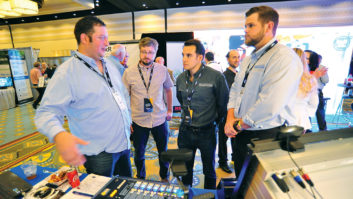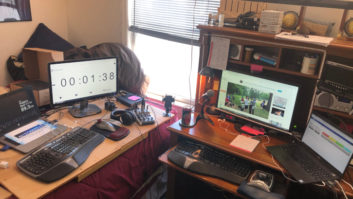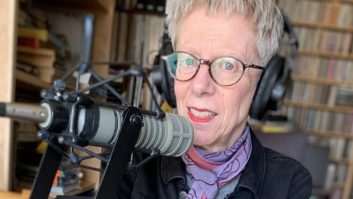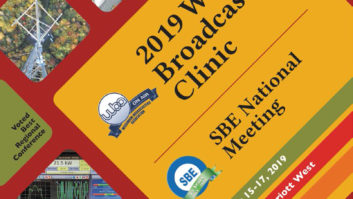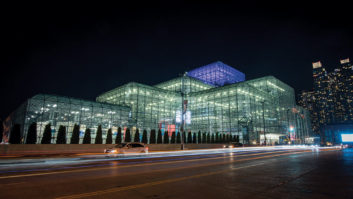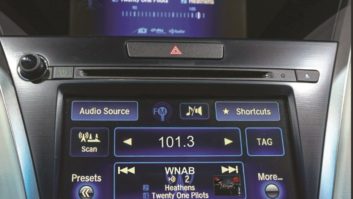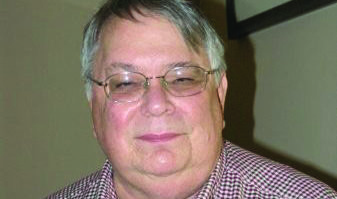AUSTIN, Texas What happens to the rules protecting TV stations on Channel 6 from FM interference when TV finalizes its digital transition next year?
NPR Labs has performed FM interference testing of DTV Channel 6 receivers to address the question. Though it did not make specific recommendations, lab officials said their results show “significant improvement in interference immunity” to FM signals in TV tuners.
Senior Technologist John Kean said NPR will seek FCC reaction before figuring out its next steps. The results were filed with the commission during a “mini” Public Radio Engineering Conference in Austin in September.
(click thumbnail)APRE President Ralph Hogan hands the official association seal to Jobie Sprinkle. Photo by Leslie Stimson
NPR itself initiated the interference testing based on two factors, according to Kean. From tests by the ATSC and the FCC Lab, NPR Labs knew that digital television should enjoy improved interference rejection, compared to analog television. Further, television tuner performance had improved since 1979, when the FCC tested interference on Channel 6 as the basis for rules used today.
Consequently, NPR expected to find an improvement in FM interference rejection. This could help reshape the rules imposed on NCE-FM stations in 1985, once full-service television goes all-digital in February.
Kean described tests on 17 DTV receiver models to determine the level of interference from signals transmitted by NCE FM stations operating on reserved FM channels to reception of TV Channel 6.
“Specifically, the tests of FM Channels 201 to 220 (88.1 to 91.9 MHz) are reported, which are required by FCC rules to protect full-service TV Channel 6 stations (47 CFR § 73.525),” states NPR Labs in the document.
“In anticipation of the conversion to digital television broadcasting and termination of analog TV transmission in early 2009, it is appropriate to reconsider the FM interference performance of receivers available to consumers for digital television reception,” states the lab.
The engineering consulting firm of Meintel, Sgrignoli and Wallace chose the models of DTV receivers for testing.
NPR told the FCC the results demonstrate that the conversion to digital transmission, along with advancements in TV tuner design, yielded substantial improvements in FM interference rejection. The 17 receivers, which ranged from premium 50-inch screens to set-top converter boxes and “USB stick” tuners, performed 20 to 25 dB better than the original analog sets across the 88.1 to 91.9 MHz sub-band.
Testing methodology consisted of applying a variable-level FM broadcast signal to the antenna terminals of an operating DTV receiver and observing the level at which picture degradation began.
Laboratory digital TV signals were generated with a Harris Broadcast CD-1A exciter driven with a sports broadcast recording to provide moving images.
Interference tests were performed with a hybrid FM IBOC signal, including both the host analog FM carrier and the digital OFDM carriers.
The NPR Labs tests on DTV receivers can be found on the FCC’s Web site in MB Docket 87-268 and MM Docket 99-325.
Lessons of Traffic Data Deployment
NPR is a member of the Broadcast Traffic Consortium, formed this year to distribute traffic data from Navteq and other location-based information.
BTC aims to build a low-cost nationwide data distribution network of stations and use their IBOC signals to broadcast the data to portable navigation devices and in-dash systems (see radioworld.com, keyword “BTC”).
About 10 NPR member stations are contributing content data to the consortium.
“HD Radio receiver penetration must increase,” Mike Starling, vice president and chief technology officer of NPR and executive director of NPR Labs, said. “Consortium members are convinced traffic is something that may move more receivers — initially even more than multicasting.”
Discussing lessons learned as stations install their equipment, Starling said, “Issues we find are typically IT-related.” To capitalize on ROI stations must have qualified IT networking expertise, he said.
Jobie Sprinkle, director of engineering for WFAE/WFHE, Charlotte, N.C., said the consortium gathers traffic data from Traffic.com, owned by Navteq, which customizes the data and sends it over the Internet to the appropriate station to be broadcast with that station’s IBOC stream.
“If you’re already an HD station, this is a low-cost entry into the wireless digital content delivery business,” said Sprinkle. Participating stations need reliable Internet access for both the studio and transmitter site.
His station purchased a Navteq-compatible RDS encoder; in order to have a core service, consortium stations typically begin their participation with RDS and then move on to IBOC.
The consortium’s goal is to establish a data network; with that in place, consumer electronics manufacturers can create consumer products.
Eight broadcasters are founding members of the consortium: Beasley Broadcast Group, Bonneville International Corp., Cox Radio Inc., Emmis, Entercom Communications Corp., Greater Media, NPR and Radio One.
APRE Is Official
The Association of Public Radio Engineers has incorporated as a non-profit organization. Its purpose is education and outreach for non-commercial radio engineers.
In Austin, the group held its first board meeting since incorporation. The group established committee chairs during the meeting.
The APRE board named Dan Mansergh of KQED(FM) San Francisco as vice-chair and Jan Andrews of NPR Labs as treasurer. Ralph Hogan, KJZZ/KBAQ, Tempe, Ariz., who has been president of the group, remains in that capacity. Mansergh also is a contributor to Radio World.
APRE named standing committee chairs: Mansergh, education and outreach; Rich Parker, Vermont Public Radio, Public Radio Engineering Conference planning; and board development, Roger Carroll, WWNO(FM), New Orleans.
Additional committee chairs: awards, Gordon Carter, WFMT(FM), Chicago; scholarship, Parker; membership, Paxton Durham, WVTF(FM), Roanoke, Va.; and strategic planning, Bruce Wahl, NPR.
Still up for debate are membership class definitions and dues amounts.






